Title: Over Hell's Track and inside Ruben's gates - Nairobi
Dates: 29th June to 2nd July GPS:
Distance: 23km Total Distance: 18,163km
Roads: Hilly in Hell’s Gate
Weather: Mild temperatures at altitude
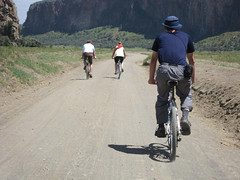 To save time and having to cycle through Nairobi, we drove from Nakuru aiming to return to Nakuru to resume the cycle journey once we had done everything in Nairobi. On the way we stopped off at Hell’s Gate National Park, near Lake Navaisha. Hell’s Gate is one of the few national parks which allow cyclists as there are no man eaters there. I thought it would be a good team-building exercise and an opportunity to get some footage of cycling past some of the animals. We hired a couple of very inadequate bikes for Zdenek and MaryJane; John and I used our bikes of course. The plan was to take a couple of hours to cycle as a team around a 20km circuit. We’d assumed that the whole park would be easy for the average cyclist and set off along the Buffalo Track which turned out to be a rough 4WD track, inappropriate for normal cycling.
To save time and having to cycle through Nairobi, we drove from Nakuru aiming to return to Nakuru to resume the cycle journey once we had done everything in Nairobi. On the way we stopped off at Hell’s Gate National Park, near Lake Navaisha. Hell’s Gate is one of the few national parks which allow cyclists as there are no man eaters there. I thought it would be a good team-building exercise and an opportunity to get some footage of cycling past some of the animals. We hired a couple of very inadequate bikes for Zdenek and MaryJane; John and I used our bikes of course. The plan was to take a couple of hours to cycle as a team around a 20km circuit. We’d assumed that the whole park would be easy for the average cyclist and set off along the Buffalo Track which turned out to be a rough 4WD track, inappropriate for normal cycling. 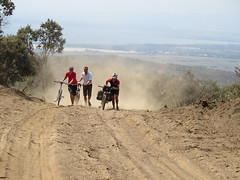 We pushed through sand and bulldust up a steep route for about 10km which MaryJane dubbed Hell’s Track – it was a baptism of fire for her – partaking in Breaking the Cycle was “breaking her will to cycle”. The positive was that the views were superb overlooking Lake Navaisha and surrounding mountains. Being a part of the Rift Valley there were a number of thermo power stations. Apparently steam rises out of the ground at about 300 degrees Celsius. After an equally rugged descent we joined up with the main track which bisects Hell’s Gate Gorge – the track which is suitable for cyclists! It was a stunning ride back to the main gate where we did see plenty of zebra, gazelles, giraffe and warthogs. From there we set off for Nairobi. The traffic was hopeless and we were late meeting our friends for dinner – Brendan, Grace, Matt and Jayden O’Brien.
We pushed through sand and bulldust up a steep route for about 10km which MaryJane dubbed Hell’s Track – it was a baptism of fire for her – partaking in Breaking the Cycle was “breaking her will to cycle”. The positive was that the views were superb overlooking Lake Navaisha and surrounding mountains. Being a part of the Rift Valley there were a number of thermo power stations. Apparently steam rises out of the ground at about 300 degrees Celsius. After an equally rugged descent we joined up with the main track which bisects Hell’s Gate Gorge – the track which is suitable for cyclists! It was a stunning ride back to the main gate where we did see plenty of zebra, gazelles, giraffe and warthogs. From there we set off for Nairobi. The traffic was hopeless and we were late meeting our friends for dinner – Brendan, Grace, Matt and Jayden O’Brien.
One of the main reasons for diverting to Nairobi was to learn about the work of one of the expedition partners the 500 Supporters’ Group. While we didn’t manage to see everything, the project we did see at Ruben Slum gave a good snapshot. Ruben is a part of Mukuru Slums where approximately 1.25 million people live in a very small area. The slums are set in behind a large industrial area.
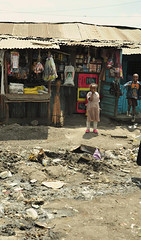 Our minibus turned off the paved road and on to a rough track lined with vendors selling just about everything – at a good price. The dried mud would be hopeless in the wet. Inside the compound, Matt introduced Zdenek and me to Brother Barry, the centre manager. The centre is run by the Christian Brothers (their organisation largely funds the programs along with the 500 Supporters’ Group and some other stakeholders). There are many initiatives in progress.
Our minibus turned off the paved road and on to a rough track lined with vendors selling just about everything – at a good price. The dried mud would be hopeless in the wet. Inside the compound, Matt introduced Zdenek and me to Brother Barry, the centre manager. The centre is run by the Christian Brothers (their organisation largely funds the programs along with the 500 Supporters’ Group and some other stakeholders). There are many initiatives in progress.
We concentrated on the health, education and microfinance loans. It appears the Kenyan government has placed Mukuru and other enormous slums such as Kibera in the too hard basket. No assistance is given for education, health, security or social development. The Ruben Centre provides a sanctuary for 1700 school children. They have about 80 students per class as it is and they have to turn people away. The health centre is the only facility of its kind in the slum – they deal with a huge number of people every day, but there are so many more that need attention.
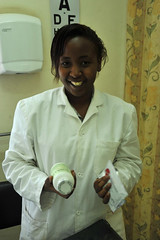 Brother Barry and Matt showed us around the health clinic. We first met Mary-Anne, the nutritionist. Most commonly she treats malnutrition. Malnourished children are prescribed with special packets of powder fortified with high protein and high energy to ensure rapid weight gain. Next we met Sarah, the HIV/AIDS counsellor. Sarah said she became a counsellor after watching her uncle die of AIDS. There were so many stigmas and myths associated with his illness. He was outcast by society and not even family members were permitted to touch him for fear of contracting the disease. Sarah’s job is to educate and dispel the myths, encourage testing and counsel those who are HIV-positive.
Brother Barry and Matt showed us around the health clinic. We first met Mary-Anne, the nutritionist. Most commonly she treats malnutrition. Malnourished children are prescribed with special packets of powder fortified with high protein and high energy to ensure rapid weight gain. Next we met Sarah, the HIV/AIDS counsellor. Sarah said she became a counsellor after watching her uncle die of AIDS. There were so many stigmas and myths associated with his illness. He was outcast by society and not even family members were permitted to touch him for fear of contracting the disease. Sarah’s job is to educate and dispel the myths, encourage testing and counsel those who are HIV-positive.
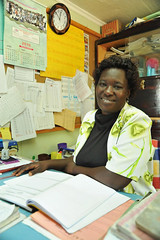 Next we met the head teacher of the school, Scholastica Opiyo. She has been running the school for 12 years and watched numbers grow until they are bursting at the seams. The 28 teachers are paid by the Christian Brothers organisation, again no help from the government. She says the children are always eager to learn and make the most of their opportunity. The lunch provided is often the students’ only meal of the day. Usually it is maize or beans.
Next we met the head teacher of the school, Scholastica Opiyo. She has been running the school for 12 years and watched numbers grow until they are bursting at the seams. The 28 teachers are paid by the Christian Brothers organisation, again no help from the government. She says the children are always eager to learn and make the most of their opportunity. The lunch provided is often the students’ only meal of the day. Usually it is maize or beans.
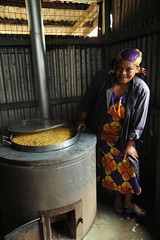 Parents are not required to pay school fees, but as a token gesture they are required to pay for the charcoal to cook the food. Even this small charge is a challenge some find difficult to meet. The kitchen was simply four huge vats of maize which was being steamed; almost ready for lunch when we looked in. Scholastica said that often children did not want to go home at the end of the day as the school environment was so much better than their home situations. She said it was often difficult to entice teachers to work in Ruben, but once they were employed, the enthusiasm of the students was a great motivator. Most teachers are committing for long periods of time.
Parents are not required to pay school fees, but as a token gesture they are required to pay for the charcoal to cook the food. Even this small charge is a challenge some find difficult to meet. The kitchen was simply four huge vats of maize which was being steamed; almost ready for lunch when we looked in. Scholastica said that often children did not want to go home at the end of the day as the school environment was so much better than their home situations. She said it was often difficult to entice teachers to work in Ruben, but once they were employed, the enthusiasm of the students was a great motivator. Most teachers are committing for long periods of time.
The microloan system offers prospective business people a leg up. Peter, the manager explained that if someone wanted a loan, they would have to present in a group so that his/her colleagues would act as guarantors. The first loan offered is very small; 15,000 shillings or $200. This is usually enough to set up a small business. They pay 15% interest which must be paid back within three months. They are then permitted to apply for a second larger loan. There are four levels of microloans, the largest being 60,000 shillings.
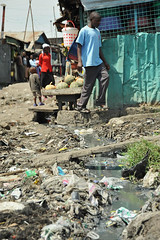 Having learned about many of the services provided on the premises, it was time to venture in to the slum. Brother Barry and community workers, Rose and Phaustine led the way. A security person followed just in case there was an issue. Barry said that in daylight hours, there should not be a problem, but at night it was an unsafe place. The first thing that struck me was the stench. It smelt like a sceptic tank. There were open channels of sewerage running down the streets and rubbish carpeting the dusty and muddy streets. It was a case of treading very carefully much of the time. The streets were lined with small corrugated iron dwellings and shops.
Having learned about many of the services provided on the premises, it was time to venture in to the slum. Brother Barry and community workers, Rose and Phaustine led the way. A security person followed just in case there was an issue. Barry said that in daylight hours, there should not be a problem, but at night it was an unsafe place. The first thing that struck me was the stench. It smelt like a sceptic tank. There were open channels of sewerage running down the streets and rubbish carpeting the dusty and muddy streets. It was a case of treading very carefully much of the time. The streets were lined with small corrugated iron dwellings and shops.
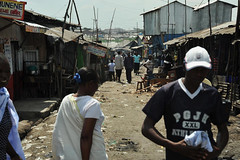 Most of the building was such that the floor levels were below the level of the street. This means that when it rains, water flows into the houses and shops – water that has washed over the open sewers – making living rooms a health hazard. There were kids everywhere, playing in the streets, following us around. I felt like the Pied Piper. Many people were busy with whatever they were doing; mostly trading. Barry explained that unemployment was one of the biggest issues and that the young men we saw hanging around the street corners and playing pool were the cause of many problems at night.
Most of the building was such that the floor levels were below the level of the street. This means that when it rains, water flows into the houses and shops – water that has washed over the open sewers – making living rooms a health hazard. There were kids everywhere, playing in the streets, following us around. I felt like the Pied Piper. Many people were busy with whatever they were doing; mostly trading. Barry explained that unemployment was one of the biggest issues and that the young men we saw hanging around the street corners and playing pool were the cause of many problems at night.
We were being led to the tiny home of Mary Makhwana who had recently been diagnosed with tuberculosis and AIDS. Rose and Phaustine had been looking after Mary, ensuring she received medical treatment and also helping her with a plan to move forward. Mary has five children. The youngest sat with me on the couch. She, like many slum dwellers, had been attracted to the potential opportunities of the big city from the country.
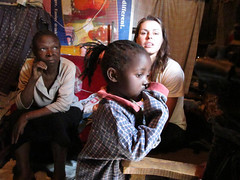 With work not forthcoming she ended up ‘trapped’ in the slum with an insignificant income and rent to pay on her little corrugated iron shack. Once she fell ill she was unable to work and has hit rock bottom. She was feeling better now that she has access to the right medication and Rose and Phaustine are trying to organise for her to return to her village in the country. There she can get family support and her children could have a better future too.
With work not forthcoming she ended up ‘trapped’ in the slum with an insignificant income and rent to pay on her little corrugated iron shack. Once she fell ill she was unable to work and has hit rock bottom. She was feeling better now that she has access to the right medication and Rose and Phaustine are trying to organise for her to return to her village in the country. There she can get family support and her children could have a better future too.
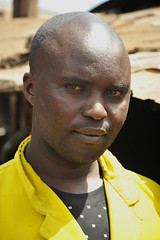 Barry, Rose and Phaustine then introduced us to Wilson, a young businessman who has benefitted from three microloans. With the money he has set up a shop, small hotel and is now looking to buy a vehicle with the profits (he makes 6000 shillings a week) and set up a small courier business. Wilson was very proud of what he has created from the loans, foresight and some hard work.
Barry, Rose and Phaustine then introduced us to Wilson, a young businessman who has benefitted from three microloans. With the money he has set up a shop, small hotel and is now looking to buy a vehicle with the profits (he makes 6000 shillings a week) and set up a small courier business. Wilson was very proud of what he has created from the loans, foresight and some hard work.
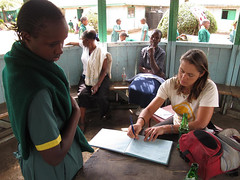 As mentioned there are other interesting projects to which the 500 Supporters’ Group contributes which are making a difference to education, health and social welfare in urban environments. The population density and living conditions are so cramped that people have no space to grow and provide food for themselves and little opportunity for work. I thank Matt and Brendan in particular for arranging our visit, especially when they had their own hectic schedules to further develop these initiatives and new partnerships.
As mentioned there are other interesting projects to which the 500 Supporters’ Group contributes which are making a difference to education, health and social welfare in urban environments. The population density and living conditions are so cramped that people have no space to grow and provide food for themselves and little opportunity for work. I thank Matt and Brendan in particular for arranging our visit, especially when they had their own hectic schedules to further develop these initiatives and new partnerships.
The other main reason for visiting Nairobi was to attain our Ethiopian visas. When I started the journey, obtaining an Ethiopian visa was possible at the border but for some reason, and without warning, they had changed the rules. We’d heard they weren’t issuing them from Nairobi or on the border in advance and had tried to no avail in Kampala. I managed to get a letter of invitation from an Ethiopian travel company and had even written a letter to the Ministry of Tourism, but the day we spent at the embassy in Nairobi was wasted. No reason was given.
There are no problems for people travelling overland from Sudan or flying in, so the reason was not for security. We then heard that a tour group had sent a representative down to the embassy in Harare, Zimbabwe and successfully collected twenty visas. It seemed to be our only option to send Zdenek down to Harare to apply for visas while I restarted the journey from Nakuru. A ridiculous waste of time and money but it was the only way, otherwise it would totally mess up the schedule.
John and I resumed the journey from Nakuru, heading to Nyahuruhu, Kenya’s highest major town. We just had to hope that Zdenek would be successful and then catch us on the road through northern Kenya.
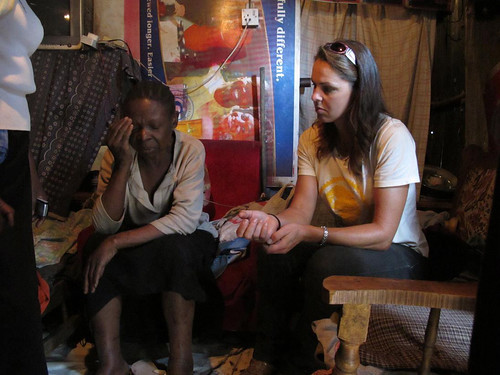


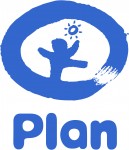

{ 1 comment… read it below or add one }
It is so awesome Kate, I feel very inspired each time I read through your diary.
May u all be strengthened each day as u cycle!
regards to JOHN, Zdenek and Mary Jane.